David Fouhey
On the Limits of Selective AI Prediction: A Case Study in Clinical Decision Making
Aug 11, 2025Abstract:AI has the potential to augment human decision making. However, even high-performing models can produce inaccurate predictions when deployed. These inaccuracies, combined with automation bias, where humans overrely on AI predictions, can result in worse decisions. Selective prediction, in which potentially unreliable model predictions are hidden from users, has been proposed as a solution. This approach assumes that when AI abstains and informs the user so, humans make decisions as they would without AI involvement. To test this assumption, we study the effects of selective prediction on human decisions in a clinical context. We conducted a user study of 259 clinicians tasked with diagnosing and treating hospitalized patients. We compared their baseline performance without any AI involvement to their AI-assisted accuracy with and without selective prediction. Our findings indicate that selective prediction mitigates the negative effects of inaccurate AI in terms of decision accuracy. Compared to no AI assistance, clinician accuracy declined when shown inaccurate AI predictions (66% [95% CI: 56%-75%] vs. 56% [95% CI: 46%-66%]), but recovered under selective prediction (64% [95% CI: 54%-73%]). However, while selective prediction nearly maintains overall accuracy, our results suggest that it alters patterns of mistakes: when informed the AI abstains, clinicians underdiagnose (18% increase in missed diagnoses) and undertreat (35% increase in missed treatments) compared to no AI input at all. Our findings underscore the importance of empirically validating assumptions about how humans engage with AI within human-AI systems.
Slot-Level Robotic Placement via Visual Imitation from Single Human Video
Apr 02, 2025



Abstract:The majority of modern robot learning methods focus on learning a set of pre-defined tasks with limited or no generalization to new tasks. Extending the robot skillset to novel tasks involves gathering an extensive amount of training data for additional tasks. In this paper, we address the problem of teaching new tasks to robots using human demonstration videos for repetitive tasks (e.g., packing). This task requires understanding the human video to identify which object is being manipulated (the pick object) and where it is being placed (the placement slot). In addition, it needs to re-identify the pick object and the placement slots during inference along with the relative poses to enable robot execution of the task. To tackle this, we propose SLeRP, a modular system that leverages several advanced visual foundation models and a novel slot-level placement detector Slot-Net, eliminating the need for expensive video demonstrations for training. We evaluate our system using a new benchmark of real-world videos. The evaluation results show that SLeRP outperforms several baselines and can be deployed on a real robot.
Stereo4D: Learning How Things Move in 3D from Internet Stereo Videos
Dec 12, 2024Abstract:Learning to understand dynamic 3D scenes from imagery is crucial for applications ranging from robotics to scene reconstruction. Yet, unlike other problems where large-scale supervised training has enabled rapid progress, directly supervising methods for recovering 3D motion remains challenging due to the fundamental difficulty of obtaining ground truth annotations. We present a system for mining high-quality 4D reconstructions from internet stereoscopic, wide-angle videos. Our system fuses and filters the outputs of camera pose estimation, stereo depth estimation, and temporal tracking methods into high-quality dynamic 3D reconstructions. We use this method to generate large-scale data in the form of world-consistent, pseudo-metric 3D point clouds with long-term motion trajectories. We demonstrate the utility of this data by training a variant of DUSt3R to predict structure and 3D motion from real-world image pairs, showing that training on our reconstructed data enables generalization to diverse real-world scenes. Project page: https://stereo4d.github.io
DEPICT: Diffusion-Enabled Permutation Importance for Image Classification Tasks
Jul 19, 2024



Abstract:We propose a permutation-based explanation method for image classifiers. Current image-model explanations like activation maps are limited to instance-based explanations in the pixel space, making it difficult to understand global model behavior. In contrast, permutation based explanations for tabular data classifiers measure feature importance by comparing model performance on data before and after permuting a feature. We propose an explanation method for image-based models that permutes interpretable concepts across dataset images. Given a dataset of images labeled with specific concepts like captions, we permute a concept across examples in the text space and then generate images via a text-conditioned diffusion model. Feature importance is then reflected by the change in model performance relative to unpermuted data. When applied to a set of concepts, the method generates a ranking of feature importance. We show this approach recovers underlying model feature importance on synthetic and real-world image classification tasks.
3DFIRES: Few Image 3D REconstruction for Scenes with Hidden Surface
Mar 13, 2024Abstract:This paper introduces 3DFIRES, a novel system for scene-level 3D reconstruction from posed images. Designed to work with as few as one view, 3DFIRES reconstructs the complete geometry of unseen scenes, including hidden surfaces. With multiple view inputs, our method produces full reconstruction within all camera frustums. A key feature of our approach is the fusion of multi-view information at the feature level, enabling the production of coherent and comprehensive 3D reconstruction. We train our system on non-watertight scans from large-scale real scene dataset. We show it matches the efficacy of single-view reconstruction methods with only one input and surpasses existing techniques in both quantitative and qualitative measures for sparse-view 3D reconstruction.
Reconstructing Hands in 3D with Transformers
Dec 08, 2023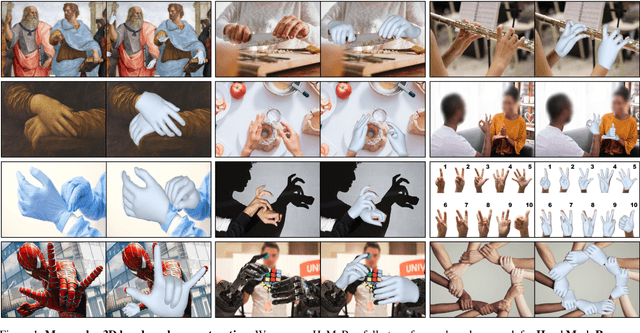
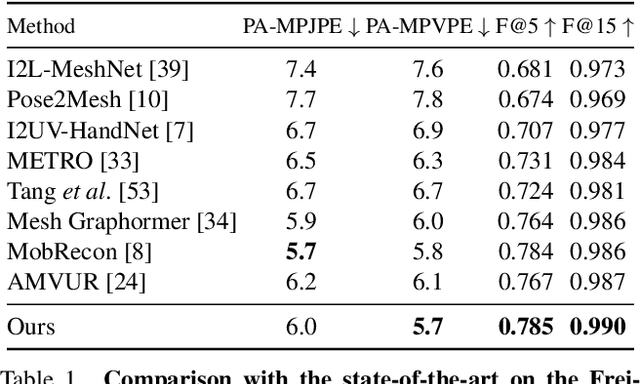
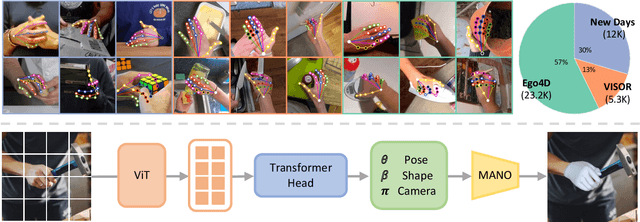
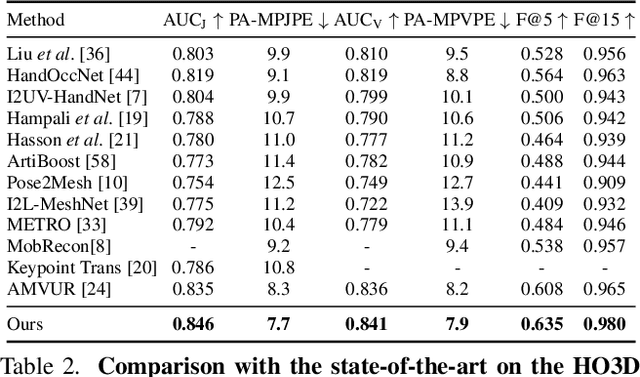
Abstract:We present an approach that can reconstruct hands in 3D from monocular input. Our approach for Hand Mesh Recovery, HaMeR, follows a fully transformer-based architecture and can analyze hands with significantly increased accuracy and robustness compared to previous work. The key to HaMeR's success lies in scaling up both the data used for training and the capacity of the deep network for hand reconstruction. For training data, we combine multiple datasets that contain 2D or 3D hand annotations. For the deep model, we use a large scale Vision Transformer architecture. Our final model consistently outperforms the previous baselines on popular 3D hand pose benchmarks. To further evaluate the effect of our design in non-controlled settings, we annotate existing in-the-wild datasets with 2D hand keypoint annotations. On this newly collected dataset of annotations, HInt, we demonstrate significant improvements over existing baselines. We make our code, data and models available on the project website: https://geopavlakos.github.io/hamer/.
NIFTY: Neural Object Interaction Fields for Guided Human Motion Synthesis
Jul 14, 2023

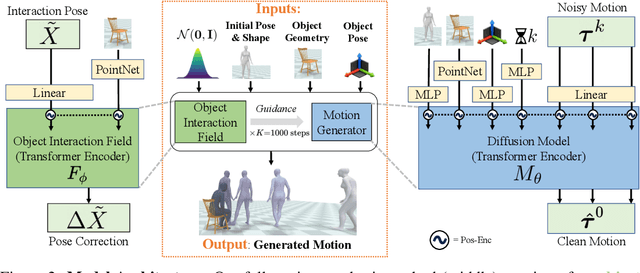
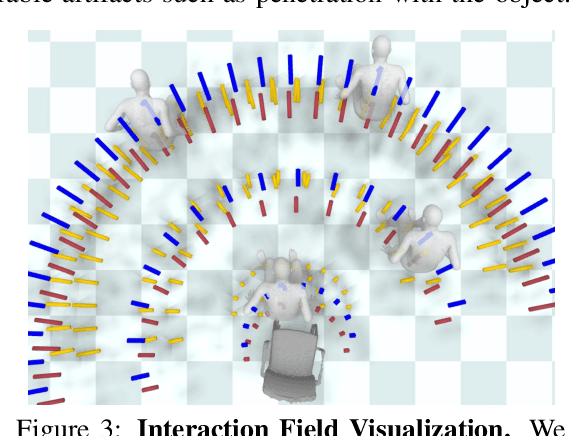
Abstract:We address the problem of generating realistic 3D motions of humans interacting with objects in a scene. Our key idea is to create a neural interaction field attached to a specific object, which outputs the distance to the valid interaction manifold given a human pose as input. This interaction field guides the sampling of an object-conditioned human motion diffusion model, so as to encourage plausible contacts and affordance semantics. To support interactions with scarcely available data, we propose an automated synthetic data pipeline. For this, we seed a pre-trained motion model, which has priors for the basics of human movement, with interaction-specific anchor poses extracted from limited motion capture data. Using our guided diffusion model trained on generated synthetic data, we synthesize realistic motions for sitting and lifting with several objects, outperforming alternative approaches in terms of motion quality and successful action completion. We call our framework NIFTY: Neural Interaction Fields for Trajectory sYnthesis.
EPIC Fields: Marrying 3D Geometry and Video Understanding
Jun 14, 2023Abstract:Neural rendering is fuelling a unification of learning, 3D geometry and video understanding that has been waiting for more than two decades. Progress, however, is still hampered by a lack of suitable datasets and benchmarks. To address this gap, we introduce EPIC Fields, an augmentation of EPIC-KITCHENS with 3D camera information. Like other datasets for neural rendering, EPIC Fields removes the complex and expensive step of reconstructing cameras using photogrammetry, and allows researchers to focus on modelling problems. We illustrate the challenge of photogrammetry in egocentric videos of dynamic actions and propose innovations to address them. Compared to other neural rendering datasets, EPIC Fields is better tailored to video understanding because it is paired with labelled action segments and the recent VISOR segment annotations. To further motivate the community, we also evaluate two benchmark tasks in neural rendering and segmenting dynamic objects, with strong baselines that showcase what is not possible today. We also highlight the advantage of geometry in semi-supervised video object segmentations on the VISOR annotations. EPIC Fields reconstructs 96% of videos in EPICKITCHENS, registering 19M frames in 99 hours recorded in 45 kitchens.
EPIC-KITCHENS VISOR Benchmark: VIdeo Segmentations and Object Relations
Sep 26, 2022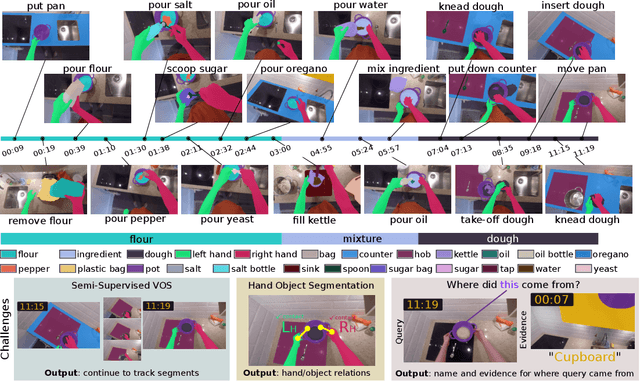

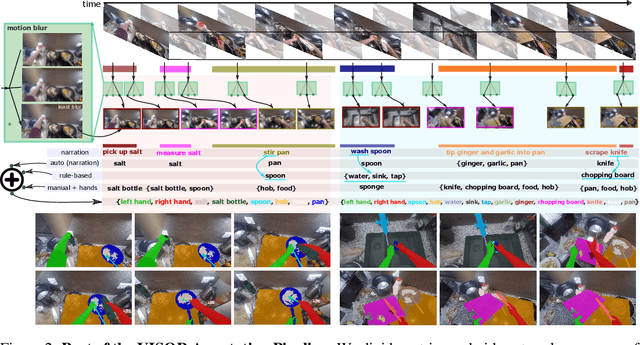

Abstract:We introduce VISOR, a new dataset of pixel annotations and a benchmark suite for segmenting hands and active objects in egocentric video. VISOR annotates videos from EPIC-KITCHENS, which comes with a new set of challenges not encountered in current video segmentation datasets. Specifically, we need to ensure both short- and long-term consistency of pixel-level annotations as objects undergo transformative interactions, e.g. an onion is peeled, diced and cooked - where we aim to obtain accurate pixel-level annotations of the peel, onion pieces, chopping board, knife, pan, as well as the acting hands. VISOR introduces an annotation pipeline, AI-powered in parts, for scalability and quality. In total, we publicly release 272K manual semantic masks of 257 object classes, 9.9M interpolated dense masks, 67K hand-object relations, covering 36 hours of 179 untrimmed videos. Along with the annotations, we introduce three challenges in video object segmentation, interaction understanding and long-term reasoning. For data, code and leaderboards: http://epic-kitchens.github.io/VISOR
Combining chest X-rays and EHR data using machine learning to diagnose acute respiratory failure
Aug 27, 2021

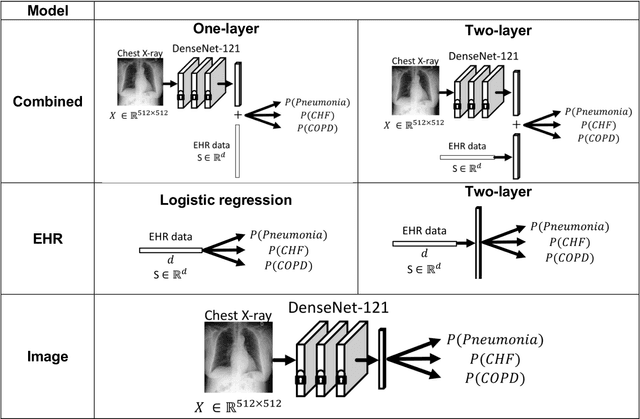

Abstract:When patients develop acute respiratory failure, accurately identifying the underlying etiology is essential for determining the best treatment, but it can be challenging to differentiate between common diagnoses in clinical practice. Machine learning models could improve medical diagnosis by augmenting clinical decision making and play a role in the diagnostic evaluation of patients with acute respiratory failure. While machine learning models have been developed to identify common findings on chest radiographs (e.g. pneumonia), augmenting these approaches by also analyzing clinically relevant data from the electronic health record (EHR) could aid in the diagnosis of acute respiratory failure. Machine learning models were trained to predict the cause of acute respiratory failure (pneumonia, heart failure, and/or COPD) using chest radiographs and EHR data from patients within an internal cohort using diagnoses based on physician chart review. Models were also tested on patients in an external cohort using discharge diagnosis codes. A model combining chest radiographs and EHR data outperformed models based on each modality alone for pneumonia and COPD. For pneumonia, the combined model AUROC was 0.79 (0.78-0.79), image model AUROC was 0.73 (0.72-0.75), and EHR model AUROC was 0.73 (0.70-0.76); for COPD, combined: 0.89 (0.83-0.91), image: 0.85 (0.77-0.89), and EHR: 0.80 (0.76-0.84); for heart failure, combined: 0.80 (0.77-0.84), image: 0.77 (0.71-0.81), and EHR: 0.80 (0.75-0.82). In the external cohort, performance was consistent for heart failure and COPD, but declined slightly for pneumonia. Overall, machine learning models combing chest radiographs and EHR data can accurately differentiate between common causes of acute respiratory failure. Further work is needed to determine whether these models could aid clinicians in the diagnosis of acute respiratory failure in clinical settings.
 Add to Chrome
Add to Chrome Add to Firefox
Add to Firefox Add to Edge
Add to Edge